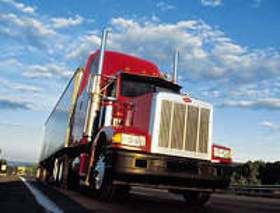Review Questions - Click On The Picture To Begin...

- Air pressure pushes a push rod out, moving the slack adjuster, thus twisting the brake cam shaft
- When driving, powerful springs are held back by air pressure and if the air pressure is removed, the springs put on the brakes
- A power screw clamps the disc or rotor between the brake lining pads of a caliper, similar to a large C-clamp
- The brake chamber push rod pushes a wedge directly between the ends of two brake shoes
Quote From The CDL Manual:
Disc brakes: In air-operated disc brakes, air pressure acts on a brake chamber and slack adjuster, like S-cam brakes. But instead of the S-cam, a "power screw" is used. The pressure of the brake chamber on the slack adjuster turns the power screw. The power screw clamps the disc or rotor between the brake lining pads of a caliper, similar to a large C-clamp.
TruckingTruth's Advice:
While it is very likely you will only drive a vehicle with S-Cam brakes, you should know the difference between S-Cam brakes, wedge brakes, and disc brakes.
- Wedge brakes may have either a single brake chamber or two brake chambers
- The brake chamber push rod pushes a wedge directly between the ends of two brake shoes
- All of these answers are accurate
- All wedge-type brakes are self-adjusting
Quote From The CDL Manual:
Wedge brakes: In these types of brakes, the brake chamber push rod pushes a wedge directly between the ends of two brake shoes. This shoves them apart and against the inside of the brake drum. Wedge brakes may have a single brake chamber or two brake chambers, pushing wedges in at both ends of the brake shoes. Wedge-type brakes may be self-adjusting or may require manual adjustment.
TruckingTruth's Advice:
Wedge brakes are derived from old technology and are very rarely used in modern commercial vehicles. However, you still may be asked a question or two about wedge brakes on your written exam.
- Too much heat will force the emergency brakes to engage
- Too much heat will activate the water-cooled emergency system
- Too much heat will cause the brakes to "catch" and potentially lock up the brakes
- Too much heat can make the brakes stop working
Quote From The CDL Manual:
Too much heat can make the brakes stop working.
TruckingTruth's Advice:
As the brake drums heat up, they become less and less effective. This is a process known as "brake fade" which is a very popular term in the trucking industry. After a while, they will become totally useless. Brake Fade is the #1 cause of brake failure on steep downgrades.
- All of these answers are accurate
- When you release the brake pedal, the S-cam rotates back, and a spring pulls the brake shoes away from the drum, letting the wheels roll freely again
- It is called an S-Cam because it's in the shape of an S
- Forces the brake shoes away from one another and presses them against the inside of the brake drum
Quote From The CDL Manual:
S-cam brakes: When you push the brake pedal, air is let into each brake chamber (see Figure 5-2). Air pressure pushes the rod out, moving the slack adjuster, thus twisting the brake cam shaft. This turns the S-cam (named because it is shaped like the letter S). The S-cam forces the brake shoes away from one another and presses them against the inside of the brake drum. When you release the brake pedal, the S-cam rotates back, and a spring pulls the brake shoes away from the drum, letting the wheels roll freely again.
TruckingTruth's Advice:
You need to study the different parts of the S-Cam air brake system. Be sure to know the major parts and understand how it works.
- Foundation brakes are used for long-term parking when it is believed the air pressure will deplete over time
- Foundation brakes are also known as the emergency brakes
- Foundation brakes are the brakes used when depressing the brake pedal
- Foundation brakes are used at each wheel and make up the individual components of the brake system
Quote From The CDL Manual:
Foundation brakes are used at each wheel. The most common type is the S-cam drum brake.
TruckingTruth's Advice:
While you may not be asked about the specific term "foundation brakes" you will absolutely need to know the different parts of an S-Cam brake drum. Be sure to study those parts and know what they do. This will be important not only for your written exam, but also your pre-trip exam.









 TT On Facebook
TT On Facebook